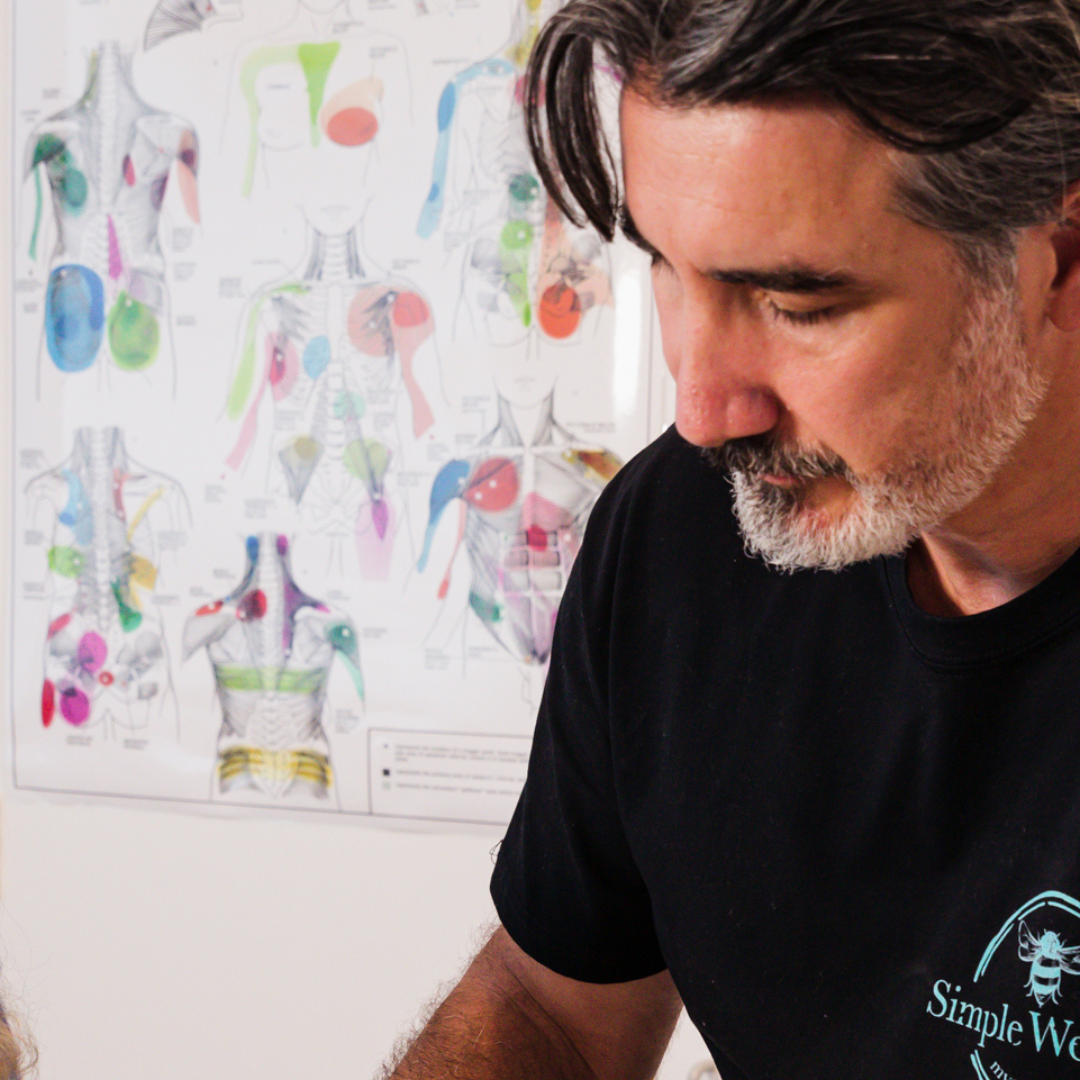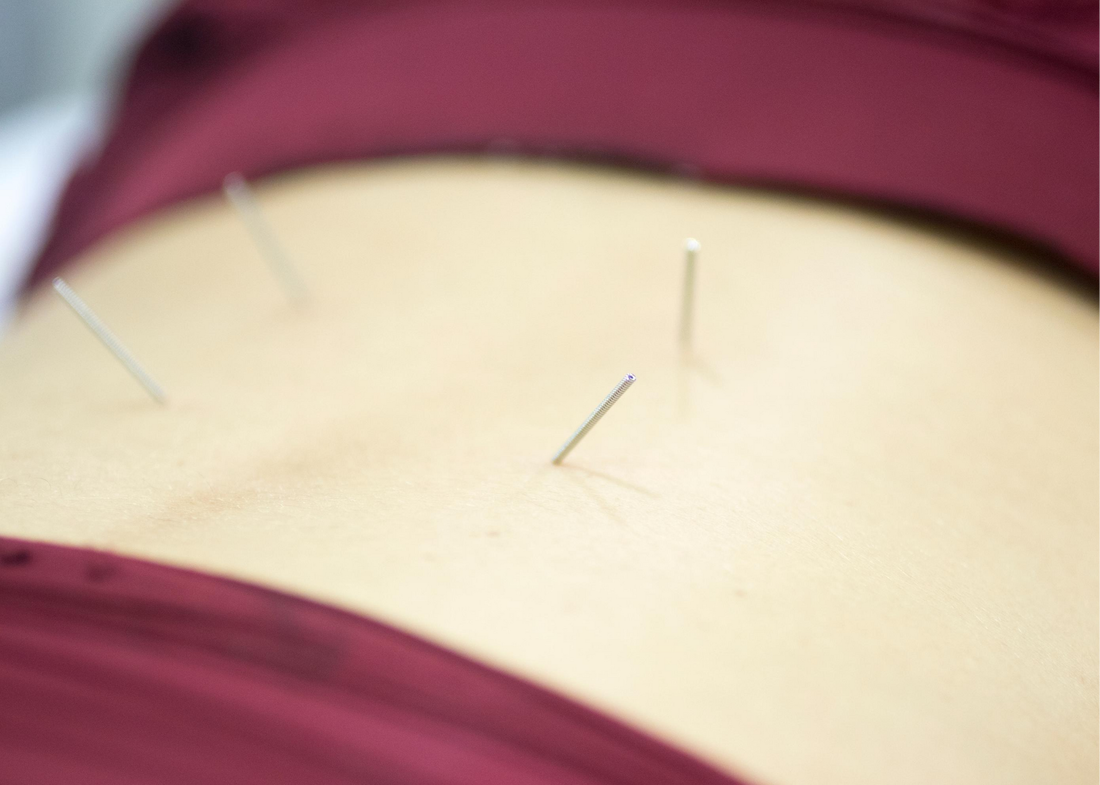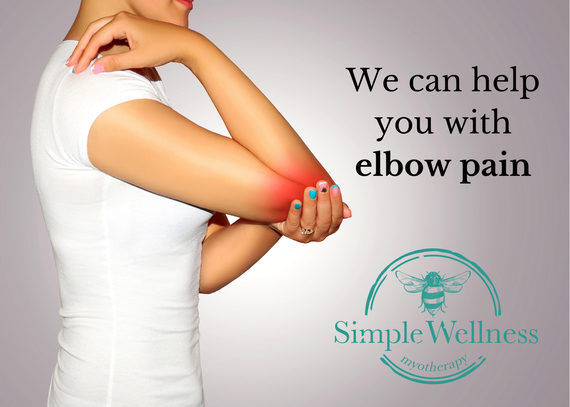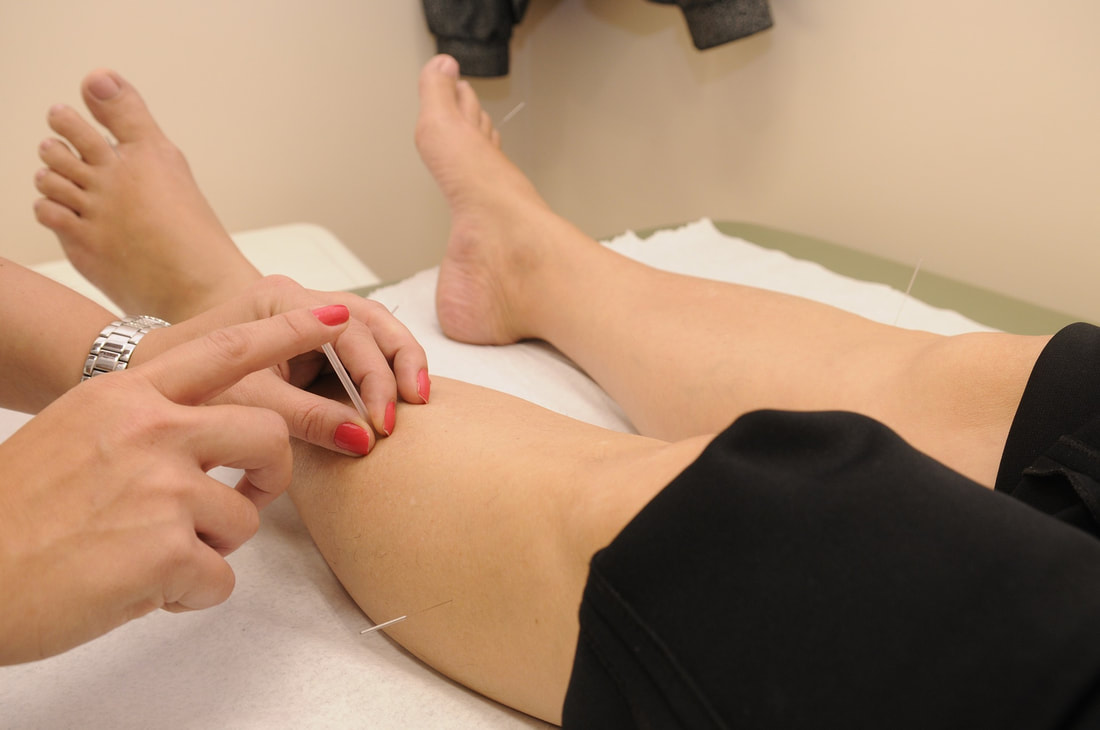|
Have you ever experienced those stubborn knots or tight spots in your muscles that seem to cause pain and discomfort? These localised areas of muscle tension are called trigger points. While they can be frustrating to deal with, the good news is that myotherapists are well-equipped to address these trigger points and provide effective relief. You might have seen the classic trigger point coloured charts in your Myotherapists treatment rooms - we have them in all three of our clinic rooms and they are fantastic tools to explain some of the most well known trigger point areas and show how far away from the problem zone that referred pain can be felt. Trigger points are hyperirritable nodules within taut bands of muscle fibers. They can develop as a result of muscle overuse, trauma, long held positions, stress, or even nutritional deficiencies. These points are typically characterized by localised pain, tenderness, and a sensation of tightness in the affected area.
They can refer pain to other parts of the body, causing discomfort in seemingly unrelated areas. Have you ever had a headache and no matter where in your head your pressed or massaged it didn't help? Chances are that your headache was being caused by a trigger point somewhere else, like in your neck, shoulders, jaw, upper back or chest. You'll be pleased to know that our Myotherapists and Remedial Massage Therapists know which muscles are likely culprits, and we're brilliant at tracking down those pesky spots that cause pain to pop up throughout your body. Myotherapy, a specialised form of manual therapy, focuses on the assessment, treatment, and prevention of musculoskeletal pain and dysfunction. Myotherapists are trained to identify trigger points and their referral patterns, and we use various techniques to quickly and effectively address them.
Trigger points can be a source of persistent pain and discomfort, but they don't have to rule your life. Myotherapists are skilled professionals who specialise in treating these bothersome knots and helping you find relief. Through trigger point release techniques, pain management strategies, and personalised exercises, our myotherapists can address the root causes of trigger points and provide lasting relief. If you're struggling with trigger points or chronic muscle tension, seeking the expertise of a qualified myotherapist could be the key to unlocking a pain-free and more functional life. Remember, you don't have to endure the discomfort—there is help available. Book a time to have our one our skilled experts begin your treatment plan, or phone us on 03 8204 0970 to get more information. Dry Needling is a manual therapy technique used by Myotherapists to help reduce pain and tension in muscles. We've previously discussed the similarities and differences between Dry Needling and Acupuncture, but you may still be wondering - how does Dry Needling actually work? The "Dry" Needle
The reason they are called "dry" needles is to differentiate them from hollow needles like the ones used for blood tests or vaccinations. A dry needle can't inject or withdraw fluids from your body. The needles themselves are ultra thin and flexible. They come with a guide tube to allow us to place them with care and precision. All needles used for dry needling are single use only. Where We Apply It Myotherapists use dry needling in painful, tight or restricted muscle groups. You may have heard about Trigger Points - those painful, tight bands that can form within a muscle over time, with repeated use or from injury. Dry needling is a technique that helps address these trigger point areas in a very specific and precise way. We assess the areas through watching you move and through palpating the muscles to find the best spots within the muscle to position the needle to relieve the trigger point. We also assess the surrounding joints and muscles, for example for hip pain we may find that dry needling in your lower back or in your thigh can help relieve pain and strain from your hip. What Happens When We Needle A Trigger Point? When we first insert the needle to the muscle, it can be felt as a little pinprick sensation on the skin. We then guide the tip of the needle into the right angle and depth of the muscle to directly stimulate the trigger point. This takes some skill and the ability to visualise in 3D the target muscle and the surrounding tissue like nerves, veins, arteries, bones and ligaments. By applying the needle into that trigger point, it causes a combination of chemical and electrical responses by the muscle. The micro damage causes by inserting the needle sends chemical messengers to the brain to get a healing response to occur. It can also cause a nerve impulse to occur, making the muscle twitch and release. To Stimulate or Not To Stimulate Because our aim in using dry needling is to get a change in the muscle tension, we often can stimulate the needle. This means we might gently move the needle in a pulsing in/out movement to repeatedly stimulate the trigger point, or we might twist the needle in a particular direction or in a series of back and forward movements. Stimulation of the needle can lead to more twitching, what we call Local Twitch Response. Dry needling can be effective even without the involuntary muscle twitch response. Some practitioners prefer a more intensive stimulation of the needles, however we prefer a gentle and slow approach. Does Dry Needling Hurt? In most cases, not really. Which is often surprising! The most common sensations you'll feel are the pinprick of the needle being positioned, a dull aching or tightening sensation around the needle, and the quick twitching response of the muscles releasing. The twitching can sometimes feel intense, but only lasts a very short time. After needling, some people can experience a little localised soreness at the sites of the needles, but most people just feel relief from tension and pain in those areas. Is Dry Needling Safe? In the hands of a trained practitioner, dry needling is a safe and effective technique. Myotherapists undergo many months of training and assessment in the skillful use of dry needling, however not all practitioners who offer dry needling are Myotherapists. Remedial Massage Therapists, Chiropractors, Physiotherapists, and other skilled practitioners can opt to undertake short courses in dry needling. Here in the Simple Wellness Myotherapy clinic, we only allow our Myotherapists to use dry needling on our patients, and we strongly believe that a weekend short course is not enough time to develop the skills needed to use dry needling safely and effectively. What Sort Of Pain Can Dry Needling Help Treat? Dry needling is great for releasing tight trigger point areas all throughout the body. It can be effective in treating headaches, neck and shoulder pain, back pain, bursitis, pain from disc injuries, sports injuries, plantar fasciitis - so many things! Want to try dry needling for your muscle pain? Book an appointment with one of our Myotherapists. Headaches are one of the most common issues our Myotherapists and Remedial Massage Therapists help people with. There are a bunch of variable ways that headaches can turn up - sometimes affecting only one side or the other; sometimes just the top, sides, or back of your head; sometimes very pinpoint spots like right behind your eyes; squeezing tension bands across your temples and eyebrows; starting from your jaw and spreading upwards; or just generally your entire head.
No matter which type you get, its never a good day if you need to persevere with a headache. There are a lot of factors that can influence headaches. Trigger points in your neck, shoulders and face can send some intense referred pain headaches, and these trigger points respond particularly well to hands on treatments like remedial massage, cupping and gentle mobilisations. Dehydration and exhaustion can be linked with headaches. If you suffer regularly, keep an eye out for your usual water intake and sleep patterns. By improving your quality of sleep and the amount of water your body has available to use, you may find your headaches reduce or go entirely! Stress and hormonal changes can also lead to headaches. Have you ever noticed how your neck, shoulders and face become much tighter when you're under stress? Do you clench your teeth, or hunch into a protective position? Some women find that they get a headache at specific times during their cycle due to changing hormone levels. Hormones are something that are outside of our scope as remedial massage and myotherapists, but many of our patients have found Acupuncture to be a useful tool in balancing hormones. Our good friend Amanda at Upwey Acupuncture can help you explore hormonal treatment options, including menstrual and menopausal symptoms. Eye strain can bring on headaches, as I found out last year! We got a new TV and I got intense tension band headaches every time I watched it for longer than about 10 minutes. My optometrist checked my vision and prescribed my glasses to help reduce the strain on my eyes, and it helped resolve my headaches! If you already wear glasses, is it time for a check up? If you don't wear glasses, perhaps an eye test could be helpful for you. Aside from taking over the counter medications like Panadol, how can you get help with easing and resolving a problematic headache? A great first step is to book with one of our therapists so we can assess your headaches and determine if they have a musculoskeletal origin. We can often help people get rid of their headache and set them up with a plan to prevent future headaches. A Short 40 Minute Initial Consultation is ideal for your first appointment to investigate your headaches. You’ve been told you have Tennis Elbow, but you don’t even play tennis? The pain can catch you off guard, and make normally simple tasks feel really difficult - opening jars, turning door handles, shaking someones hand, maintaining your grip on something. This type of pain can feel like a deep muscle aching, a stretch in the muscle, sharpness when you move, or a combination of these feelings. Our Myotherapists and Remedial Massage Therapists can help by creating a treatment plan for you that relieves the pain and gives you back your strength and ability to turn, twist and grip again.
Tennis Elbow is a painful condition of irritation and inflammation of the tendons around the outer side of your elbow. Its normal to feel the dull, constant ache throughout the day, and have the pain turn into sudden, sharp or shooting pain when you move your elbow or wrist, or try to grip something or twist a lid or door handle. It can happen if you spend a lot of time doing repetitive wrist movements like typing, using tools, carrying something heavy for a long period of time. We see it with people who play musical instruments too, or video gamers who get so into the game they forget to take a break for hours on end. Our typical treatments for this kind of pain will look at assessing your movement and strength first so we can plan out some short and long term goals. Our short term goals are usually the ones you want the most - to get rid of this awful pain!! But its also important to plan for the long term goals of recovering the strength in the area so that this feeling doesn't come back. A series of hands on treatments can help to reduce the pain and sensitivity in the area, and we'll give you a few movements that help that you can focus on between treatments. This is a pain that tends to respond well to doing some stretch and strengthening movements each day, starting with small easy movements, working up to more challenging or weight resisted ones. The hands on part of your treatment may include some remedial massage, cupping, active release techniques, dry needling, and trigger point therapy. Afterwards we can support your elbow with kinesiotaping to reduce pressure over the joint and tendons. Do you need help with elbow pain? Our therapists are ready to help assess your pain and work with you to create a treatment plan to reduce the irritation and restore your movement and strength. Book your first consultation with us now! Most people have some idea about acupuncture, even if they don't know exactly how it works. But many aren’t sure about the difference between acupuncture needling and dry needling. This is a question that comes up all the time during myotherapy sessions! So let’s look at the key similarities and differences. The Similarities
First, let’s look at the common ground between the two forms of treatment. The needles Both use needles as the tool of treatment. These needles can come in various lengths and thicknesses depending on what they are used for. Needles should always be sterilised and single-use. The training Qualified practitioners have to be trained extensively in how to correctly needle a client. Learning where, when and how to use a needle on a human body is a bit intimidating, but it is essential for safety reasons. Whether you get acupuncture from a Traditional Chinese Medicine practitioner or dry needling from your Myotherapist, you can rest easy knowing there has been months or even years spent on training. However, dry needling courses can also be offered as short weekend courses for practitioners like remedial massage therapists, physiotherapists, chiropractors, etc. If I'm honest, I don't think these courses are long enough, in depth enough, and with enough assessment and examination of each participant. Acupuncturists and Myotherapists train for a long period of time, need to pass both written and practical exams, and complete student clinic treatments under supervision to build their needling competency. The Differences Now we get to the differences between the two forms of treatment. Why it’s done & what it treats Acupuncture is a Traditional Chinese Medicine practice, with thousands of years of use. It is used as one treatment form to bring the body back into balance according to TCM treatment protocols, the most familiar of these being the system of meridians, or energy points throughout the body. Acupuncture can be used to balance hormones, optimise digestion, reduce stress and treat a lot of conditions, including musculoskeletal issues. I'm always very honest with people when I say that I don’t understand the theory or application well because I’m not a trained acupuncturist, and I refer any more specific acupuncture questions to Amanda Cox-Edwards at Upwey Acupuncture. Dry needling is a modern physical therapy. It is used to correct imbalances in musculoskeletal health. The goal is to release tension in a muscle, returning it to its natural, neutral tone. Dry needling is used specifically for muscle and joint complaints, as a comparison to acupuncture which has more system wide applications. Where it is used Acupuncture can be used directly over an area of concern. But it can also be used distally – that is, a distant point on the body that is related to the area of concern according to the meridians. Certain points on the bodies surface relate to other areas, including internally. Of course, your acupuncturist won't needle directly into your kidneys to treat a kidney issue or into your intestines to treat a digestive issue, they will use the TCM protocols to stimulate points throughout the muscles and skin of your body that relate to the kidneys or digestive system. On the other hand, dry needling is used directly on the affected muscles. We find the muscle that is tight, spasming or needs to be released, and then locate the spots of most tension within that muscle and that becomes our needling target zone. How the needle is used The final major difference is how the needle itself is used as a tool. In acupuncture, the practitioner will insert the needle in the specific spot and depth and generally leave it to do its job while the client relaxes. This can be for up to 45 minutes, depending on what they are treating. Dry needling is not left alone. Instead, the practitioner will often try to stimulate the muscle fibres by moving the needle, helping to release the tension. The most commonly used stimulation techniques include an up-down motion to repeatedly hit the target within the muscle; a twisting action to wind and release the tissue; and in-out motions on an angle to release broader areas of tension. Some therapists take an aggressive approach to dry needling, and it can be uncomfortable or even painful to receive needling from this type of therapist. By now, you probably know that I'm your gentle Myotherapist, so in typical gentle fashion I use very slow, deliberate stimulation techniques where needed. I also like to let my needles rest then re-stimulate it a few minutes later, rather than continuous stimulation. Dry needling is just one tool out of a big, broad toolbox that Myotherapists have to use. Scared of needles? We have plenty of other ways to gently encourage your muscles to relax and release without needing to use needles on you. Does dry needling sound like something you want to try? The good news is that myotherapists have extensive and ongoing training in dry needling. So book yourself in a session to try it today. |
Meet Our Team
We have a team of great practitioners available 7 days a week at our Rowville clinic. Archives
July 2024
Categories
All
|
Got a question about Myotherapy?
Contact Mel by phone, email or Facebook
|
Simple Wellness Myotherapy & Remedial Massage Clinic
Shop 12B 150 Kelletts Rd Rowville VIC 3178 |
Phone us on
03 8204 0970 |






 RSS Feed
RSS Feed